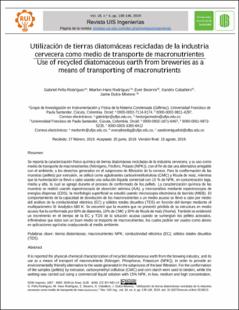Use of recycled diatomaceous earth from breweries as a means of transporting of macronutrients
Artículo de revista
2019-09-16
Revista UIS Ingenierías
Bogota , Colombia
Se reporta la caracterización físico-química de tierras diatomáceas recicladas de la industria cervecera, y su uso como
medio de transporte de macronutrientes (Nitrógeno, Fósforo, Potasio (NPK)), con el fin de dar una alternativa amigable
con el ambiente, a los desechos generados en el subproceso de filtración de la cerveza. Para la conformación de las
muestras (pellets) por extrusión, se utilizó como aglutinantes carboximetilcelulosa (CMC) y fécula de maíz, mientras
que la humectación se llevó a cabo usando una solución líquida comercial con 15 % de NPK, en concentración baja,
media y alta, la cual se agregó durante el proceso de conformado de los pellets. La caracterización química de las
muestras se realizó usando espectroscopía de absorción atómica (AA), y microanálisis mediante espectroscopia de
energías dispersas (EDS), la morfología superficial se estudió usando microscopia electrónica de barrido (MEB). El
comportamiento de la capacidad de devolución de los macronutrientes a un medio acuoso se llevó a cabo por medio
del análisis de la conductividad eléctrica (EC) y sólidos totales disueltos (TDS) en función del tiempo mediante el
multiparámetro SI Analytics 680 K. Se encontró que la muestra que no presentó pérdida de su estructura en medio
acuoso fue la conformada por 60% de diatomita, 10% de CMC y 30% de fécula de maíz (%w/w). También se evidenció
un incremento en el tiempo de la EC y TDS de la solución acuosa cuando se sumergían los pellets activados,
infiriéndose que éstos son un buen medio se trasporte de macronutrientes, los cuales podrán ser usados como abono
en aplicaciones agrícolas coadyuvando al medio ambiente It is reported the physical-chemical characterization of recycled diatomaceous earth from the brewing industry, and its use as a means of transport of macronutrients (Nitrogen, Phosphorus, Potassium (NPK)), in order to provide an environmentally friendly alternative to the waste generated in the subprocess of the beer filtration. For the conformation of the samples (pellets) by extrusion, carboxymethyl cellulose (CMC) and corn starch were used to binders, while the wetting was carried out using a commercial liquid solution with 15% NPK, in low, medium and high concentration which was added during the pellet forming process. The chemical characterization of the samples was done using atomic absorption spectroscopy (AA), and microanalysis by dispersed energy spectroscopy (EDS), the surface morphology was studied using scanning electron microscopy (SEM). The behavior of the macronutrient return capacity to an aqueous medium was carried out by means of the analysis of the electrical conductivity (EC) and total dissolved solids (TDS) as a function of time using the SI Analytics 680 K multiparameter. It was found that the sample that did not present loss of its structure in aqueous medium was formed by 60% of diatomite, 10% of CMC and 30% of corn starch (%w/w). Also the increase in the time of the EC and TDS of the aqueous solution when the activated pellets were submerged was observed, inferring that these are a good means of transporting macronutrients, which can be used as fertilizer in agricultural applications contributing to the environment.
Descripción:
Use of recycled diatomaceous earth from breweries as a means of transporting of macronutrients.pdf
Título: Use of recycled diatomaceous earth from breweries as a means of transporting of macronutrients.pdf
Tamaño: 840.8Kb
 PDF
PDF
 LEER EN FLIP
LEER EN FLIP
Título: Use of recycled diatomaceous earth from breweries as a means of transporting of macronutrients.pdf
Tamaño: 840.8Kb
 PDF
PDF
 LEER EN FLIP
LEER EN FLIP
















